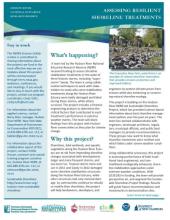
Battered by tides, ice, storms, and human activity, nearly half of New York state's Hudson River shoreline has been “armored up ” by structures such as steel bulkheads or rock revetments. While these structures can protect vulnerable infrastructure in high-energy situations, they also disrupt surrounding habitats. In response, the Hudson River Reserve launched the Sustainable Shorelines project, a long-term, collaborative initiative that is advancing understanding of the engineering, economic, and ecological tradeoffs of using different shoreline management options today—and as the climate shifts and sea levels rise—for generations to come.
As part of this project, the team conducted a forensic analysis of shoreline structures on the Hudson River following three historic storms to understand how sites with traditional vs. non-traditional nature-based shoreline stabilization techniques were impacted by severe storms in 2011 and 2012. This study includes case studies describing each site and the forensic engineering analysis used to determine the critical factors that contributed to each treatment's performance. Two additional reports describe the common project performance factors and methodology used in the project.
Rella, A. & Miller, J. 2015. Forensic Analysis: Methodology Report. In association with and published by the Hudson River Sustainable Shorelines Project, Staatsburg, NY, https://www.hrnerr.org/shorelinesforensicanalysis